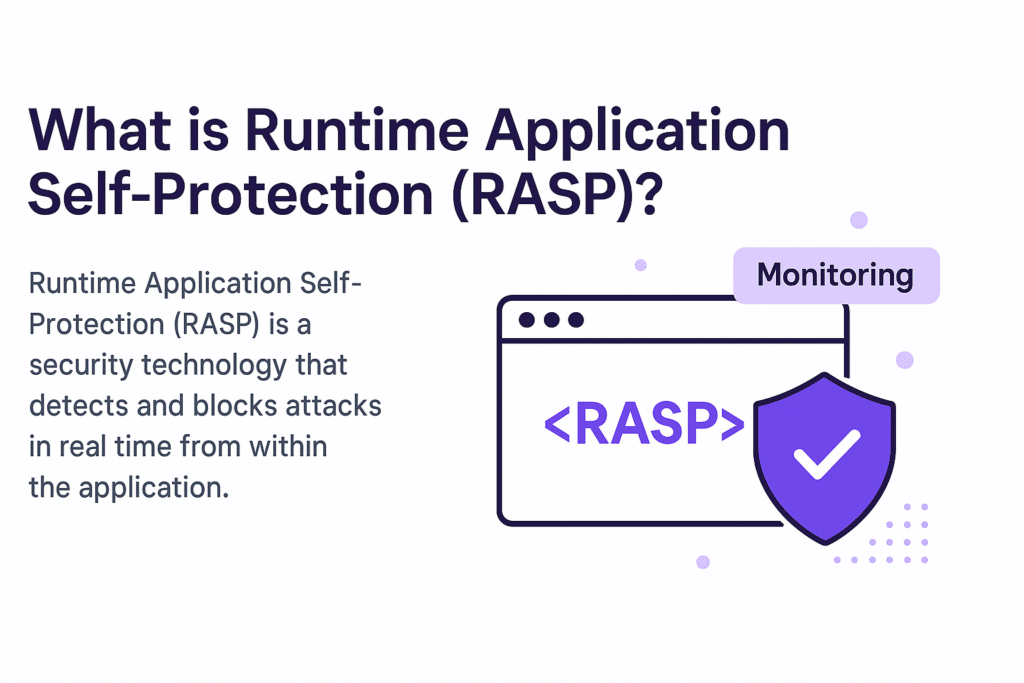Summary
- Runtime Application Self-Protection (RASP) is a security technology that detects and blocks attacks in real time from within the application.
- By embedding security directly into the application runtime, RASP provides immediate protection against threats like SQL injection and cross-site scripting (XSS).
- This is crucial for CISOs, compliance officers, and development teams aiming to safeguard applications without altering source code.

What Is Runtime Application Self-Protection (RASP)?
Runtime Application Self-Protection (RASP) is a security technology that integrates with an application’s runtime environment to monitor and protect against real-time threats.
Unlike traditional security measures that operate at the network perimeter, RASP works from within the application, providing contextual awareness and immediate response to attacks.
How It Works
Runtime Application Self-Protection (RASP) operates by embedding sensors within the application, allowing it to monitor inputs, outputs, and behavior during execution.
When a threat is detected—such as malicious input or unauthorized access—RASP can automatically block the action, terminate sessions, or alert security teams.
This real-time protection is achieved without the need for external security tools or modifications to the application’s source code.
Who’s at Risk
Organizations deploying web applications, APIs, or mobile apps are particularly vulnerable to runtime attacks.
Industries handling sensitive data—such as finance, healthcare, and e-commerce—are prime targets for attackers exploiting vulnerabilities during application execution.
Without RASP, these applications may lack the necessary defenses to detect and prevent sophisticated threats in real time.
Real-World Examples
- SQL Injection Attacks: Attackers exploit input fields to execute malicious SQL commands, potentially compromising databases.
- Cross-Site Scripting (XSS): Malicious scripts are injected into web pages, affecting users and compromising data integrity.
- Zero-Day Exploits: Previously unknown vulnerabilities are exploited before patches are available, leading to unauthorized access or data breaches.
In each case, RASP can detect and mitigate these threats in real time, preventing potential damage.
How to Detect or Prevent It
Traditional security tools like Web Application Firewalls (WAFs) and Intrusion Detection Systems (IDS) operate at the network level and may not detect threats within the application.
RASP complements these tools by providing in-depth, application-level protection.
Implementing RASP involves integrating it into the application runtime, enabling continuous monitoring and immediate response to threats without altering the application’s codebase.
How Feroot Helps
Feroot offers solutions that enhance client-side security, ensuring that applications are protected against runtime threats.
By integrating Feroot’s tools, organizations can monitor application behavior, detect anomalies, and respond to threats in real time, all without modifying existing code.
This proactive approach ensures compliance with security standards and protects sensitive data from emerging threats.
FAQ
How does RASP differ from traditional security tools like WAFs?
While WAFs monitor traffic at the network perimeter, RASP operates within the application, providing real-time protection by analyzing application behavior and context.
Is RASP suitable for all types of applications?
RASP is particularly beneficial for applications that handle sensitive data or require high security, such as financial, healthcare, and e-commerce platforms.
Does implementing RASP require changes to the application’s source code?
No, RASP integrates with the application’s runtime environment and does not necessitate modifications to the source code.
Can RASP protect against zero-day vulnerabilities?
A: Yes, RASP can detect and block previously unknown threats by monitoring application behavior and identifying anomalies in real time.


